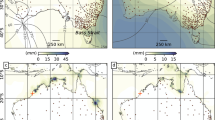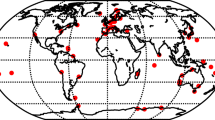Abstract
We use up to a 6-year span of GPS data from 85 globally distributed stations to compare solutions using ocean tidal loading (OTL) corrections computed in different reference frames: center of mass of the solid Earth (CE), and center of mass of the Earth system (CM). We compare solution sets that differ only in the frame used for the OTL model computations, for three types of GPS solutions. In global solutions with all parameters including orbits estimated simultaneously, we find coordinate differences of ~0.3 mm between solutions using OTL computed in CM and OTL computed in CE. When orbits or orbits and clocks are fixed, larger biases appear if the user applies an OTL model inconsistent with that used to derive the orbit and clock products. Network solutions (orbits fixed, satellite clocks estimated) show differences smaller than 0.5 mm due to model inconsistency, but PPP solutions show distortions at the ~1.3 mm level. The much larger effect on PPP solutions indicates that satellite clock estimates are sensitive to the OTL model applied. The time series of coordinate differences shows a strong spectral peak at a period of ~14 days when inconsistent OTL models are applied and smaller peaks at ~annual and ~semi-annual periods, for both ambiguity-free and ambiguity-fixed solutions. These spurious coordinate variations disappear in solutions using consistent OTL models. Users of orbit and clock products must ensure that they use OTL coefficients computed in the same reference frame as the OTL coefficients used by the analysis centers that produced the products they use; otherwise, systematic errors will be introduced into position solutions. All modern products should use loading models computed in the CM frame, but legacy products may require loading models computed in the CE frame. Analysts and authors need to document the frame used for all loading computations in product descriptions and papers.
Similar content being viewed by others
References
Agnew DC (1997) NLOADF: a program for computing ocean-tide loading. J Geophys Res 102: 5109–5110
Amiri-Simkooei AR, Tiberius CCJM, Teunissen PJG (2007) Assessment of noise in GPS coordinate time series: Methodology and results. J Geophys Res 112: B07413. doi:10.1029/2006JB004913
Blewitt G (2003) Self-consistency in reference frames, geocenter definition, and surface loading of the solid Earth. J Geophys Res 108(B2). doi:10.1029/2002JB002082
Blewitt G (2008) Fixed point theorems of GPS carrier phase ambiguity resolution and their application to massive network processing: Ambizap. J Geophys Res 113: B12410. doi:10.1029/2008JB005736
Boehm J, Niell A, Tregoning P, Schuh H (2006) Global Mapping Function (GMF): A new empirical mapping function based on numerical weather model data. Geophys Res Lett 33: L07304. doi:10.1029/2005GL025546
Boehm J, Heinkelmann R, Schuh H (2007) Short note: a global model of pressure and temperature for geodetic applications. J Geod. doi:10.1007/s00190-007-0135-3
Dong D, Dickey JO, Chao Y, Cheng MK (1997) Geocenter variations caused by atmosphere, ocean and surface ground water. Geophys Res Lett 24: 1867–1870
Dong D, Yunck T, Heflin M (2003) Origin of the international terrestrial reference frame. J Geophys Res 108(B4): 2200. doi:10.1029/2002JB002035
Dragert H, James TS, Lambert A (2000) Ocean loading corrections for continuous GPS: a case study at the Canadian coastal site Holberg. Geophys Res Lett 27(14): 2045–2048
Egbert GD, Erofeeva L (2002) Efficient inverse modeling of barotropic ocean tides. J Atmos Ocean Technol 19: 183–204
Farrell WE (1972) Deformation of the Earth by surface loads. Rev Geophys 10: 761–797
Fok HS, Iz HB, Shum CK, Yi Y, Andersen O, Braun A, Chao Y, Han G, Kuo CY, Matsumoto K, Song YT (2010) Evaluation of ocean tide models used for jason-2 altimetry corrections. Marine Geod 33(1 supp 1): 285–303
Fritsche M, Dietrich R, Knöfel C, Rülke A, Vey S, Rothacher M, Steigenberger P (2005) Impact of higher-order ionospheric terms on GPS estimates. Geophys Res Lett 32: L23311. doi:10.1029/2005GL024342
Goad CC (1980) Gravimetric tidal loading computed from integrated Green’s functions. J Geophys Res 85: 2679–2683
Gross R, Beutler G, Plag HP (2009) Integrated scientific and societal user requirements and functional specifications for the GGOS. Global Geodetic Observing System 209–224
IERS Conventions (2010) Gérard Petit, Brian Luzum (eds) (IERS Technical Note; 36) Frankfurt am Main: Verlag des Bundesamts für Kartographie und Geodäsie, 2010. 179 pp., paperback, in press
Kedar S, Hajj GA, Wilson BD, Heflin MB (2003) The effect of the second order GPS ionospheric correction on receiver positions. Geophys Res Lett 30(16): 1829. doi:10.1029/2003GL017639
King MA, Watson CS, Penna NT, Clarke PJ (2008) Subdaily signals in GPS observations and their effect at semiannual and annual periods. Geophys Res Lett 35: L03302. doi:10.1029/2007GL032252
Kouba J (2009) A Guide to Using International GNSS Service (IGS) Products. http://igscb.jpl.nasa.gov/components/usage.html
Penna NT, Stewart MP (2003) Aliased tidal signatures in continuous GPS height time series. Geophys Res Lett 30(23): 2184. doi:10.1029/2003GL018828
Penna NT, King MA, Stewart MP (2007) GPS height time series: short-period origins of spurious long-period signals. J Geophys Res 112: B02402. doi:10.1029/2005JB004047
Penna NT, Bos MS, Baker TF, Scherneck HG (2008) Assessing the accuracy of predicted ocean tide loading displacement values. J Geod 82: 893–907. doi:10.1007/s00190-008-0220-2
Ray J, Altamimi Z, Collilieux X, van Dam T (2008) Anomalous harmonics in the spectra of GPS position estimates. GPS Solut 12: 55–64. doi:10.1007/s10291-007-0067-7
Scherneck HG, Johansson JM, Webb FH (2000) Ocean loading tides in GPS and rapid variations of the frame origin. Geodesy Beyond 2000—The Challenges in the First Decade vol. 121, Schwarz, Springer, Berlin 2000
Schmid R, Steigenberger P, Gendt G, Ge M, Rothacher M (2007) Generation of a consistent absolute phase center correction model for GPS receiver and satellite antennas. J Geod 81(12): 781–798. doi:10.1007/s00190-007-0418-y
Stewart MP, Penna NT, Lichti DD (2005) Investigating the propagation mechanism of unmodelled systematic errors on coordinate time series estimated using least squares. J Geod 79(8): 479–489. doi:10.1007/s00190-005-0478-6
Thomas ID, King MA, Clarke PJ (2007) A comparison of GPS, VLBI and model estimates of ocean tide loading displacements. J Geod 81: 359–368. doi:10.1007/s00190-006-0118-9
Tregoning P, van Dam T (2005) Effects of atmospheric pressure loading and seven-parameter transformations on estimates of geocenter motion and station heights from space geodetic observations. J Geophys Res 110: B03408. doi:10.1029/2004JB003334
Tregoning P, Watson C (2009) Atmospheric effects and spurious signals in GPS analyses. J Geophys Res 114: B09403. doi:10.1029/2009JB006344
Tregoning P, Watson C (2011) Correction to “Atmospheric effects and spurious signals in GPS analyses”. J Geophys Res 116: B02412. doi:10.1029/2010JB008157
Urschl C, Dach R, Hugentobler U, Schaer S, Beutler G (2005) Validating ocean tide loading models using GPS. J Geod 78: 616–625. doi:10.1007/s00190-004-0427-9
Vey S, Calais E, Llubes M, Florsch N, Woppelmann G, Hinderer J, Amalvict M, Lalancette MF, Simon B, Duquenne F, Haase JS (2002) GPS measurement of ocean loading and its impact on zenith tropospheric delay estimates: a case study in Brittany, France. J Geod 76(8): 419–427. doi:10.1007/s00190-002-0272-7
van Dam T, Wahr J, Chao Y, Leuliette E (1997) Predictions of crustal deformation and of geoid and sea-level variability caused by oceanic and atmospherc loading. Geophys J Int 129: 507–517
Yuan LG, Ding XL, Zhong P, Chen W, Huang DF (2009) Estimates of ocean tide loading displacements and its impact on position time series in Hong Kong using a dense continuous GPS network. J Geod 83: 999–1015. doi:10.1007/s00190-009-0319-0
Zumberge JF, Heflin MB, Jefferson DC, Watkins MM, Webb FH (1997) Precise point positioning for the efficient and robust analysis of GPS data from large networks. J Geophys Res 102(B3): 5005–5017
Author information
Authors and Affiliations
Corresponding author
Rights and permissions
About this article
Cite this article
Fu, Y., Freymueller, J.T. & van Dam, T. The effect of using inconsistent ocean tidal loading models on GPS coordinate solutions. J Geod 86, 409–421 (2012). https://doi.org/10.1007/s00190-011-0528-1
Received:
Accepted:
Published:
Issue Date:
DOI: https://doi.org/10.1007/s00190-011-0528-1




